Reading Corporation Transport
Reading Corporation Transport
Reading's first motor buses were AEC YC types, and these were followed over the years by Guy and Karrier machines, including some of the decidedly dubious six wheelers from both makers. In 1929, the first of eleven Leyland TD1s arrived, and then from 1933, the Corporation turned to the AEC Regent, which, apart from four wartime Guy Arabs, and a batch of twelve Crossley DD42/8 in 1950, remained the preferred double deck design right up to 1957. Reading then turned to the excellent Dennis Loline III with Gardner 6LX engine, taking eight in 1962, ten more in 1964, and a final eight in 1966.
Post WW2, the single deck fleet consisted of some Bedford OBs, but, between 1957 and 1965, a fleet of 32 AEC Reliances arrived. These had dual doorway bodies by Burlingham and then Neepsend with space for 26 standing passengers. The Corporation then switched its favours to the Bristol RELL, taking no less than forty-two in 1967 and 1968 to replace the withdrawal of the trolleybuses. The first batch had Strachans two doorway bodies, but the later ones had bodywork built by Seddon's Pennine Coachcraft to a very similar appearance. Like the Reliances before them, these REs were of the standee layout, but with space for 35 standing passengers. This accommodation compared poorly with that of the withdrawn trolleybuses, and the REs were extremely unpopular with the travelling public.
The Reading trolleybus system opened on 18 July 1936, and gradually replaced the Reading tramway network. The system worked efficiently and profitably, but, by the mid 1960s, most other trolleybus systems had closed. Trolleybus equipment was no longer produced and Reading Corporation decided to abandon its trolleybus system, the routes being withdrawn between January 1967 and November 1968.
Since the 1960s, notwithstanding the 1986 Transport Act and deregulation, Reading has continued to run its own bus fleet, but the nightmarish, psychedelic, migraine inducing colour schemes of the present day bear no civilised comparison with the dignified maroon and cream livery of yesteryear. A link to a historic fleet list may be found at the foot of the gallery.
Roger Cox
12/2012
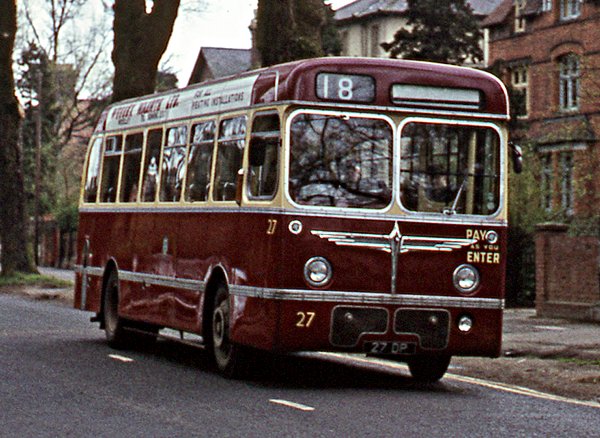
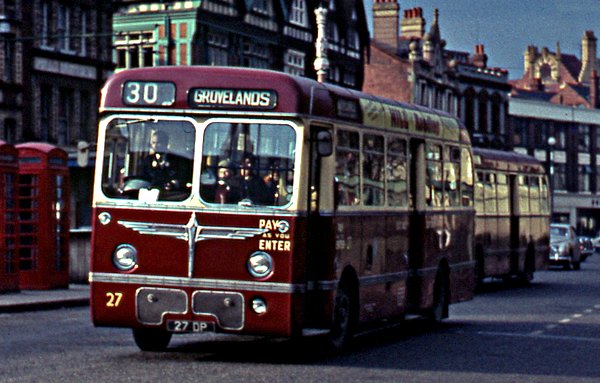
Two shots of 27, 27 DP fleet an AEC Reliance with Burlingham B34D+26 bodywork new in 1962.
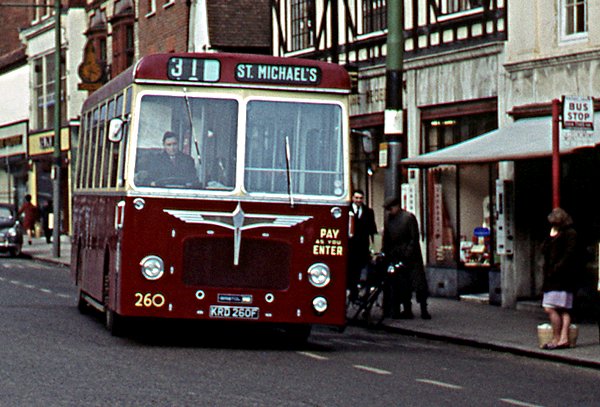
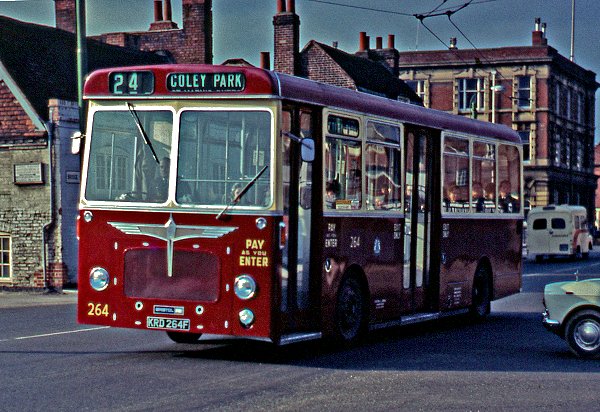
260, KRD 260F and 264, KRD 264F are examples of the first batch of Bristol RELL6G with Strachans B34D+35 bodies. Later REs had visually very similar bodies by Pennine with the same internal accommodation arrangement. A picture of the Pennine bodied version may be seen here.
Interestingly, the Strachans bodied examples outlived the newer Pennine machines.
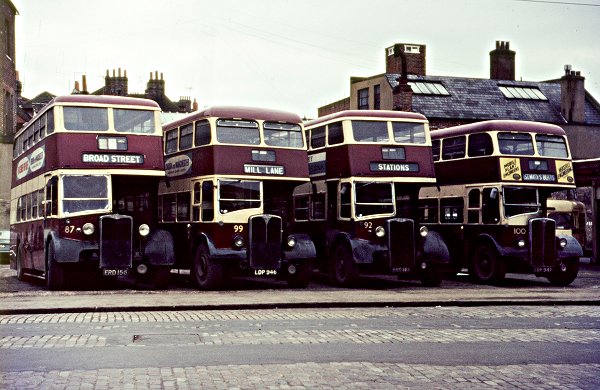
A line up of Reading's standard double deck types before the advent of the Loline.
87, ERD 156 Crossley DD42/8 Crossley L26/26RD (New 1950)
99, LDP946 AEC Regent III Park Royal L53RD (New 1955)
92, ERD 161 Crossley DD42/8 Crossley L26/26RD (New 1950)
100, LDP947 AEC Regent III Park Royal L53RD (New 1955)
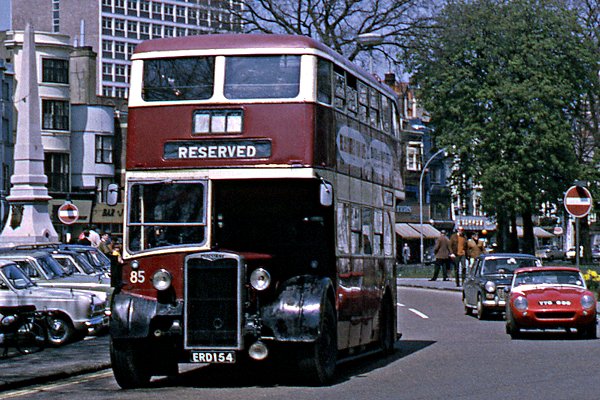
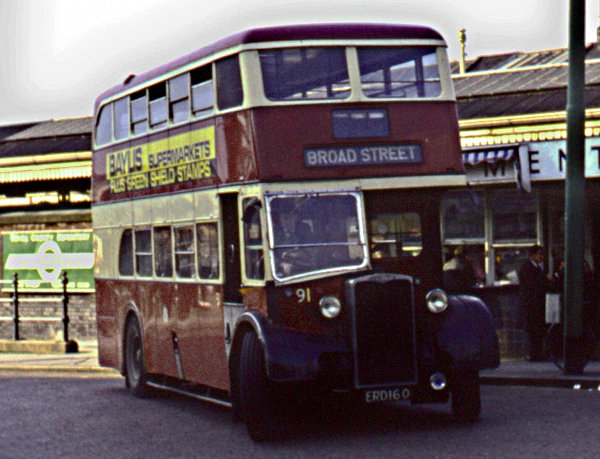
Two more Crossley DD42/8 with Crossley L26/26RD bodies. 85, ERD 154 and 91, ERD 160.
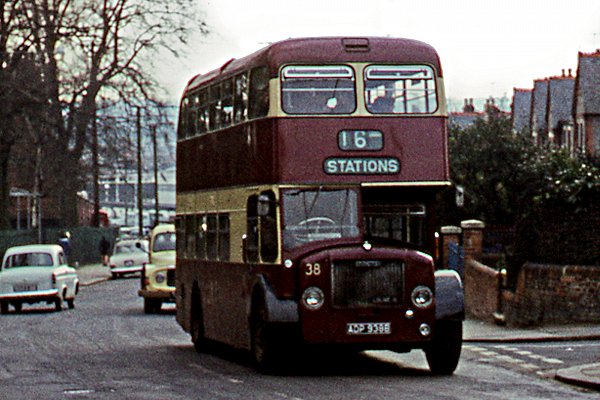
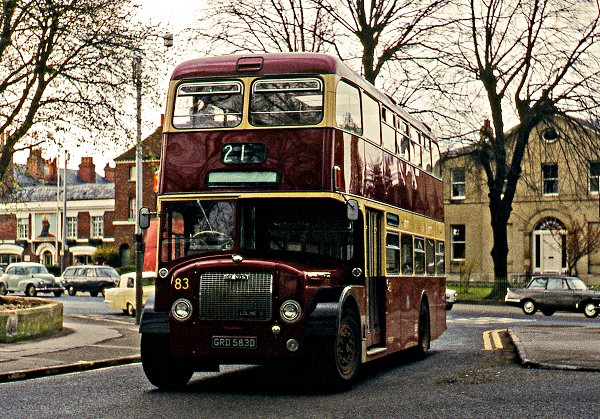
38, ADP 938B Dennis Loline III with East Lancs H38/30F bodywork was new in August 1964.
83, GRD 583D also with East Lancs body, came in December 1966.
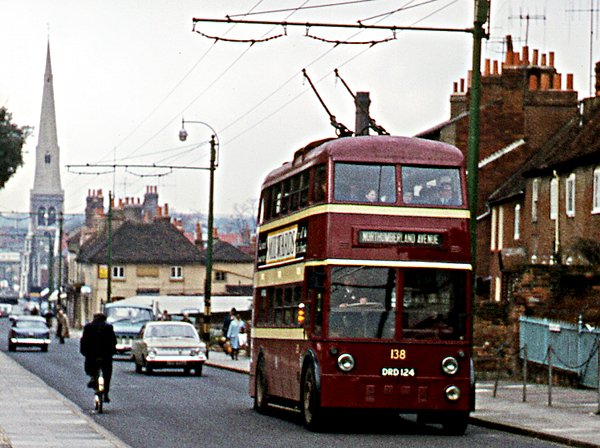
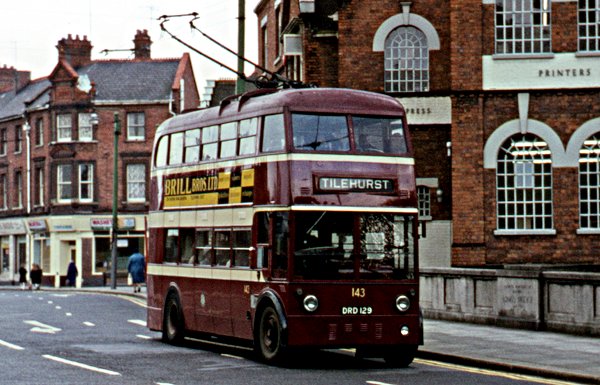
138, DRD 124 and 143, DRD 129 are BUT 9611T machines with Park Royal H30/26RD bodies. Both were new in July 1949.
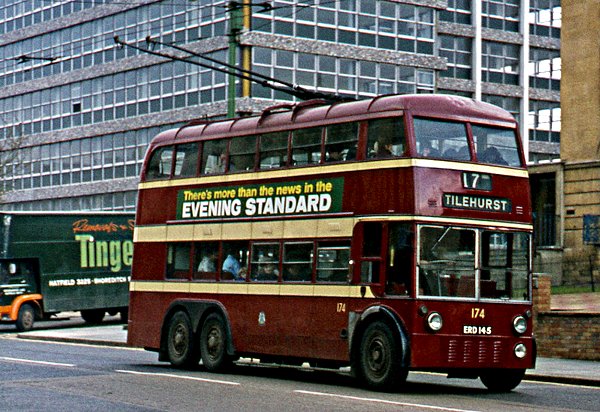
174, ERD 145 is a Sunbeam S7 with Park Royal H38/30RD body, new in November 1950. Thankfully, this trolleybus is now preserved.
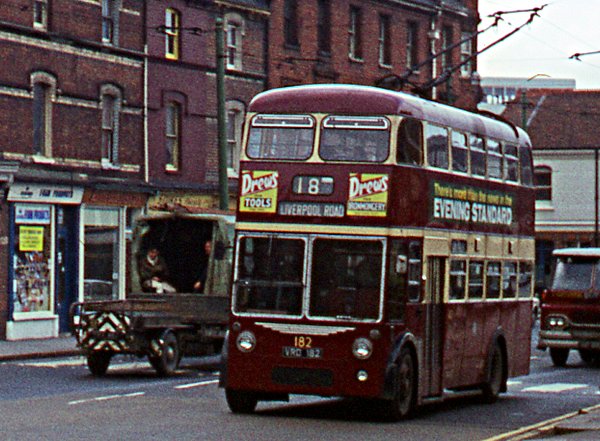
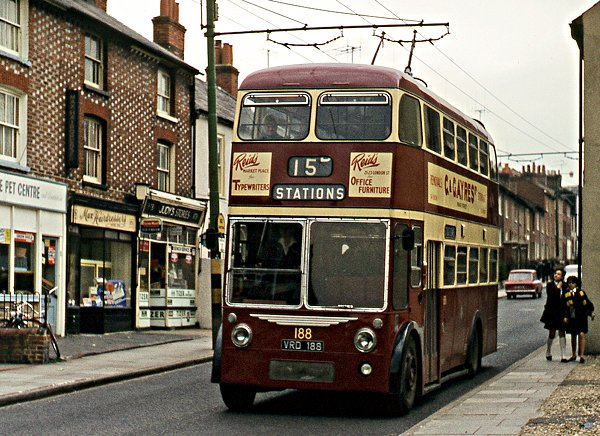
Reading's last trolleybus deliveries were twelve Sunbeam F4A vehicles with Burlingham H38/30F bodywork. Here are Nos. 182 and 188, both new in August 1961 with matching VRD registration numbers.
Five of these Sunbeam F4As, Nos 184-6/192, were purchased by the small Teesside Municipal Transport system in January 1969. At the last minute, Teeside tried to cancel the deal in favour of purchasing shorter trolleys from Bournemouth instead, but Reading insisted that the contract was binding. This unpropitious start was borne out in practice. In their short time on Teesside they suffered from mechanical problems (one achieved only three months service) and their extra length proved a problem at the very tight North Ormesby turning point. Nevertheless, they remained in use until the Teesside system closed on 18 April 1971.
Here is a link to download a historic fleet list of Reading Corporation Transport
14/12/12 - 16:32
Roger, thanks for an excellent gallery which brings back many memories. I arrived in Reading the Sunday after the end of the trolleybus service for my induction course with Huntley, Boorne and Stevens who were in the middle of a move from their Victorian factory on London Rd to their new factory at Woodley.
I had a four week stay in Reading before taking up my duties as North of England representative and was able to observe the early days of the Bristol REs as well as gaining a walk around the depot with its varied collection of buses and just withdrawn trolleys.
With regard to the current colour schemes, the one thing in their favour is that they highlight the modernity and independence of the department in the face the national monoliths, which must be something to be commended.
Phil Blinkhorn
15/12/12 - 07:49
My experience was of a part-timer with Reading Mainline through the competition days until the last day, in corporation ownership, when I was one of the drivers. The halcyon days were over, but they were still a class act - just no vehicles with character and an insipid livery, no match for the livery shown here.
I would take issue over the current livery. I'm a traditionalist and a professional grumpy old man but there are good new liveries. The Delaine is an example of a superb traditional livery but Reading's liveries are (just) good - just not traditional - but they are not, by definition, psychedelic (i.e. I'm off my trolley and having a fit in a paint factory)! We don't have to accept dumbing down modernity, but let's be gracious enough to acknowledge certain things, even when we dislike them.
David Oldfield
Roger - many thanks for your excellent gallery of Reading. I started my career in public transport with Reading Transport, and there was no doubt that it was an excellent place to learn the business.
A few amplifications to Roger's excellent text:
The Reliances were introduced as standee vehicles on the basis that their nominal capacity (including standees) was much the same as the deckers they replaced, but of course enabled the conversion to OMO. A good argument to put to politicians, but of course less convincing with the passengers. They were generally a nice vehicle to drive, although by the time I got to them the gearboxes could be a bit worn. In the winter, bicycle clips were definitely recommended; they were draughty around the pedals. They also had a tendency for the saloon heating system to airlock with the inevitable 'heaters and demisters' defect report.
The text implies that the REs were trolleybus replacement vehicles. This is only partly true. The 16 to Whitley Wood and the 18 between Armour Hill and Liverpool Road were converted to OMO on the conversion, but route 17 remained crew operated until the arrival of the VRs (Jumbos) between 1971 and 1976. Route 15 to Northumberland Avenue remained crew operated until the demise of the Lolines.
For a town where one of the main products was biscuits, it's perhaps appropriate that the REs were the nearest thing to a biscuit tin on wheels in Britain. The redeeming feature was the continued application of the Burlingham style chrome-work on the dash. A careful look shows that they are not quite an exact copy of the Burlingham original.
Finally, there are some things which don't change - compare this photo with this photo.
It's remarkable that this movement is still permitted in the middle of a main road.
Alan Murray-Rust
15/12/12 - 07:54
I believe 268 of the Reliances was a short time preservation attempt. It was purchased by a group in Dewsbury but it was sold for scrap shortly after purchase.
Philip Carlton
I haven't visited Reading for several years now, but I understand that the present day local bus network is commendably efficient and popular. We are, of course, all entitled to our individual views, and this makes this site so lively, but, as a migraine sufferer since childhood, I cannot agree with David Oldfield over the present array of Reading Transport liveries. Here are a few to be getting on with. Placing Delaine in this lurid company I find to be rather curious. The Delaine livery is in the classic character that prevailed generally in an earlier age. I live quite locally to the Delaine operations - in fact, I was in Bourne today - and I regard the restrained, dignified livery to be light years distant from the computer generated aberrations that now seem to infest the bus industry. Another local independent that gets this right and which I use regularly is Norfolk Green, which has recently revised its livery to include grey with new shades of green in the "modern" painting style, and it still works visually. Reading may have a marketing point in wishing to attract attention with vivid, individually colour coded route liveries, but I don't like them one bit.
Roger Cox
17/12/12 - 08:19
I knew that I would get a reaction from Roger, but I stick by what I said - especially as Roger obviously read what he wanted to see and not what I actually said. My point was exactly that the Delaine is head and shoulders above the likes of Readings liveries - being traditional in the very best sense - but that Reading's liveries cannot by definition be psychedelic. [I have clinically been a migraine suffer from an early age.]
David Oldfield
17/12/12 - 11:06
Thanks, Roger, for the Reading Gallery, which as well as bringing back memories raises many points and queries.
a) Modern liveries: I do thoroughly agree with those who dislike the gimmicky liveries that have assaulted us over the last 25 years: arbitrary parallelograms and blocks of colour deliberately ignoring the architecture of the vehicle, and---worse still---those swooshes of vinyl that sweep across windows, blocking the view. Thames Travel, which runs an excellent service over downland and through woods between Oxford and Reading has some claustrophobic single-deckers in which you have to ask fellow-passengers where you are even in broad daylight. I recognise the logic of the route-brand colours in Reading, though much of it's lost on me, with my very poor colour memory. The toothpaste mauve of the Scania Omnicitys now on the 23 matches the hazardous staircase and noisy upstairs fan on these buses, which I hope will be the next to leave the fleet. But all that's a minor cavil against the background of the huge strides made by Reading Transport over the last twelve years.
b) Old liveries: Until 1947, Corporation bus window frames were maroon, but one day Dad pointed out to me through the bedroom window a brand-new bus with cream round the windows, a feature seen on all subsequent new motorbuses, but not applied to older ones. It was not until 1958, when the last prewar (1938) Regents were withdrawn, that all motorbuses had cream round the windows, yet all trolleybuses continued with maroon window frames until the 1961 Sunbeams, which sported cream. Why?
c) Odd points of interest:
1) Some of our 1926-30 Guy B single-deckers stayed in service till 1947.
2) Our 1929-32 Leyland TD1s and one 1933 Regent kept their petrol engines until disposal in 48-49.
3) The 1933-34 Regents and 1936 Sunbeam no 1, our first trolleybus, were (I think) unique for rear-entrance lowbridge buses in having straight staircases.
4) We ran our 1950 Crossleys up hill and down dale for 17-18 years, so they can't have been that bad.
5) The 1956-57 batches of Regent IIIs were the last to have 7.7-litre engines and crash gearboxes.
6) Some of the 1939 AEC trolleybuses ran for 22 years.
7) Correct me if I'm wrong here: we had the biggest municipal fleet of Dennis Lolines, which returned over 13mpg in service.
d) Opinions and questions:
1) I thought the 1967-68 Bristol "Cattle Trucks", with their huge windows, were handsome vehicles. It's a pity that the political and economic thinking of the time should decree that 35 of their passengers should stand.
2) Rumour has it that General Manager Royston Jenkins said that had he taken over from the redoubtable William John Evans a year earlier he could have saved the trolleybus system from abandonment. Is that true?
Alan---you can probably give us the definitive answer on that one!
Finally, I'm lucky: both Oxford (where I live now) and Reading have second-to-none bus services.
Ian Thompson
17/12/12 - 15:55
In reply to Ian's question about Royston Jenkins and the trolleybus conversion, I have no personal knowledge of his views. Essentially, by the time I joined RT the trolleybuses were well gone and such thoughts were water under the bridge. However, a reliable source indicates that the rumour is not unfounded, but that it was more a question of a pragmatic approach to vehicle replacement than saving the system - prolongation rather than long term retention. I have also had pointed out some inaccuracies in my comments about the OMO conversion chronology, picking up aspects which had occurred before I had arrived. Service 15 was converted to OMO with the withdrawal of the trolleybuses, but was then later re-converted to crew operation to release sufficient vehicles for the conversion of route 17 to OMO. This later phase of crew operation excluded late evening and Sunday working for which adequate OMO vehicle resources were available. Service 18 was initially crew-operated from the end of trolleybus operation and was not converted to OMO until 1970(-ish)
Alan Murray-Rust
17/12/12 - 17:12
OK, David, let's say that, to me at least, many of the modern liveries are seemingly 'psychedelically inspired'. The modern trend in public transport paintwork, bus and rail, appears to be driven by people ensconced in their publicity agency ivory towers, who have no fundamental knowledge of the businesses that they are 'promoting'. When everything about is screaming for visual attention, the lot merely merges into a chaotic blur. This debate could run and run, so I had better stop there.
I am grateful to Alan and Ian for their in depth knowledge of the fascinating Reading fleet. Ian's point about the possible extension to the life of the trolleybus system is intriguing. Those operators that did retain trolleybus networks up to the 1960s/1970s all seemed to capitulate to the diesel bus at much the same time, which suggests that the availability of trolley equipment and spares was becoming a critical issue. No doubt Reading could have kept going for a while longer, but the lack of new production would surely have told in the end.
Roger Cox
Comments regarding the above are more than welcome please get in touch via the 'Contact Page' or by email at obp-admin@nwframpton.com
If you have any bus related photographs that you would like to appear in a gallery on this website please send them to me by email at obp-admin@nwframpton.com
All rights to the design and layout of this website are reserved
Old Bus Photos from Saturday 25th April 2009 to Wednesday 3rd January 2024